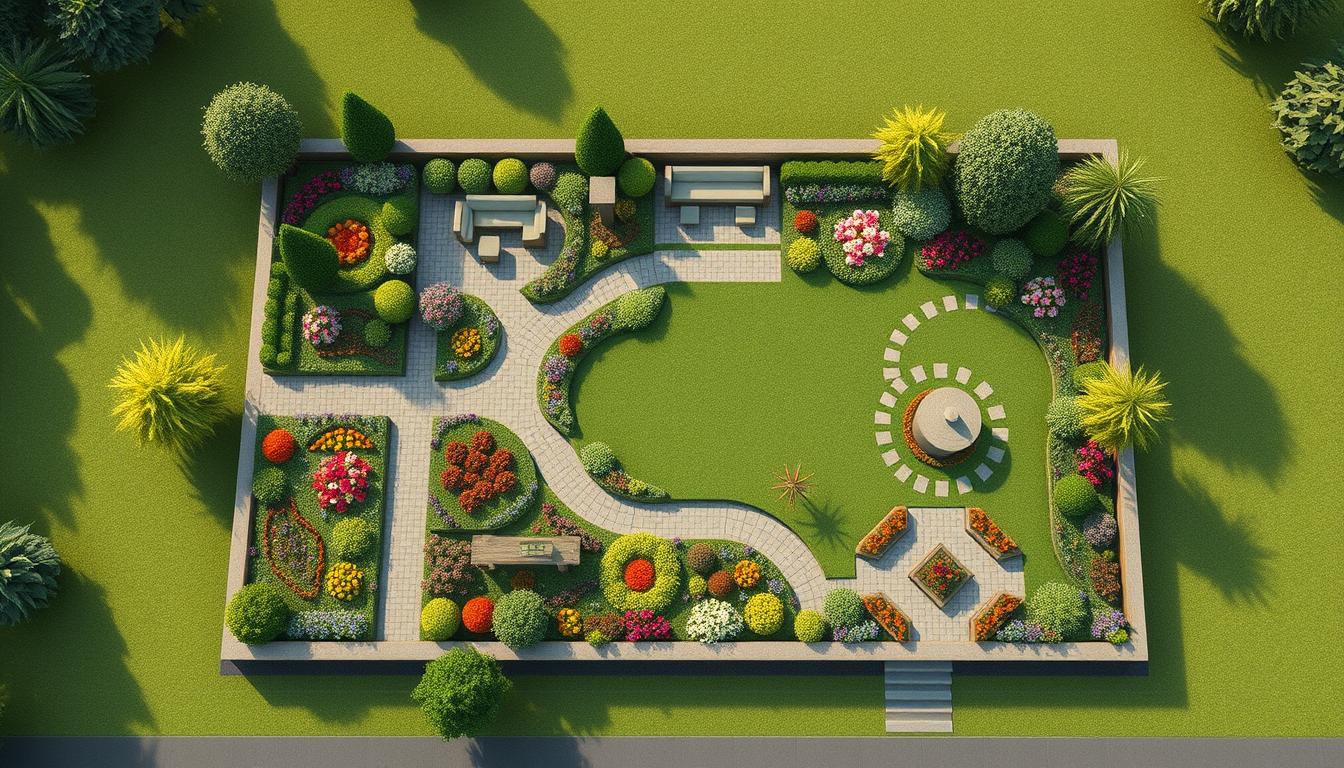Creating a beautiful outdoor space starts with planning your garden layout. The right design can turn your yard into a stunning oasis. I’ll share my top tips to help you choose the best plants and style for your garden.
A well-planned garden layout is key to a beautiful and functional space. By understanding your soil and climate, you can create a low-maintenance garden. Whether you’re new to gardening or have experience, I’m here to help.
We’ll explore garden design together, focusing on practical advice. I’ll show you how to pick the right plants and create a beautiful space. Let’s start this journey to a stunning garden layout, filled with helpful tips and ideas.
Understanding Your Space and Environment
Creating a stunning outdoor space starts with knowing your backyard. Look at the sunlight, measure your garden, and note slopes, soil, and wind. This way, your DIY garden plan fits your space perfectly.
Walk around your garden to see where the sun shines and where it’s shady. This helps you pick the best spots for plants and features. Also, measure your garden to figure out its size and shape. This makes your garden both useful and beautiful.
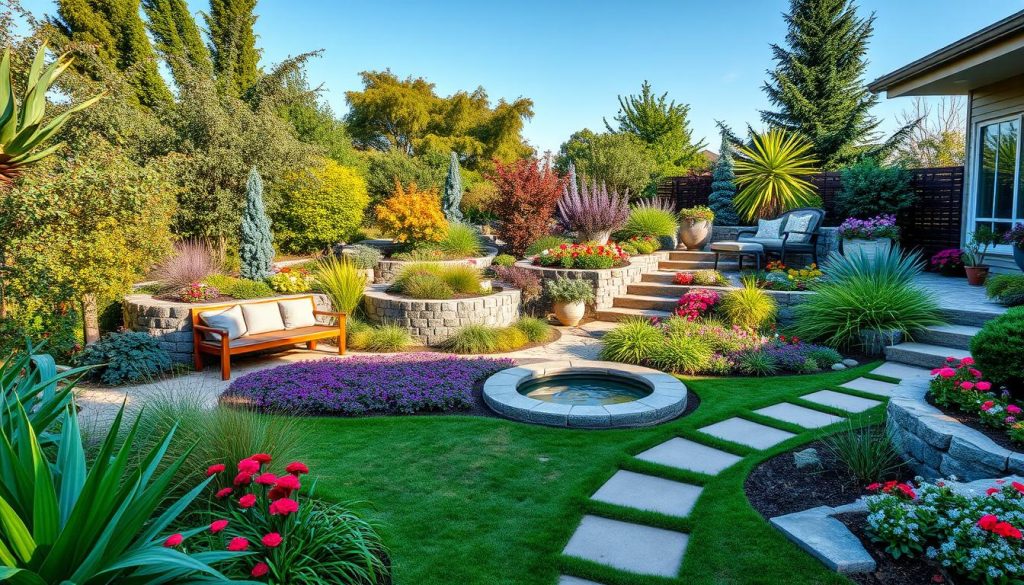
- Slope and elevation: How does the land slope and elevate in your garden?
- Soil type: What type of soil do you have, and how will it affect plant growth?
- Wind direction: Which direction does the wind come from, and how will it impact your garden?
By thinking about these factors and planning carefully, you can make a beautiful and useful DIY garden. It will improve your outdoor living space.
| Factor | Considerations |
|---|---|
| Sunlight | Amount of direct sunlight, shade patterns |
| Soil type | Clay, sand, loam, pH levels |
| Wind direction | Prevailing wind direction, potential windbreaks |
Defining Your Garden Goals and Style
When planning my garden, I first need to set my goals and style. I decide what I want to grow, like veggies, flowers, or both. I look at garden design ideas and landscaping tips to make it beautiful and useful. I also think about how to arrange my plants, considering sunlight and space.
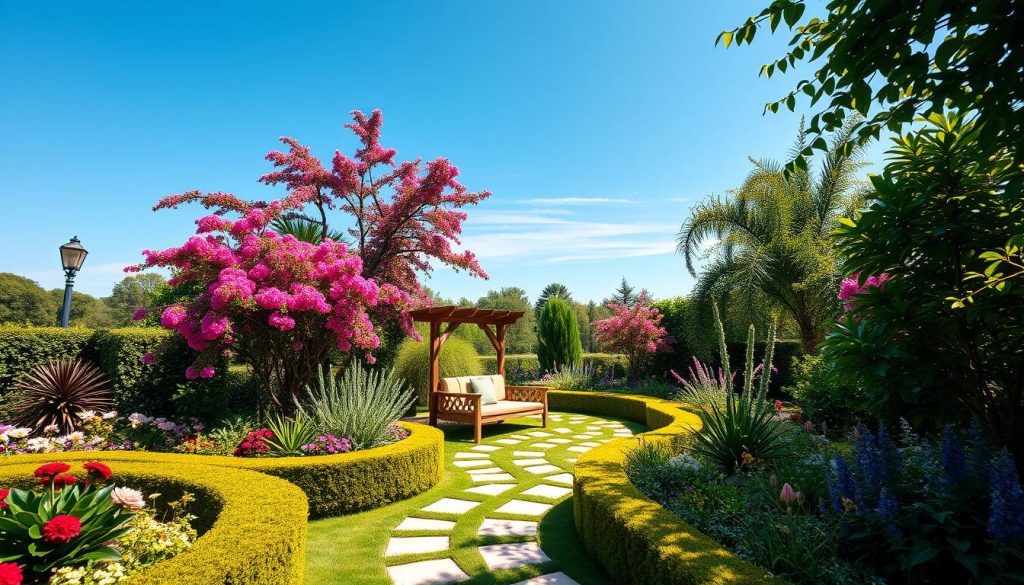
What Do I Want to Grow?
I think about what I like, the climate, and how much time I have for gardening. I make a list of plants, considering their needs and growth. This helps me arrange plants in a way that will make my garden flourish.
Choosing a Theme or Aesthetic
Choosing a theme or aesthetic helps me focus and create a unified look. I look at modern, traditional, or cottage-style themes. By picking a theme, I can make a garden that’s both beautiful and functional, showing off my personal style.
| Garden Style | Description |
|---|---|
| Modern | Characterized by clean lines, minimal ornamentation, and a focus on functionality. |
| Traditional | Features classic elements, such as symmetrical layouts and ornate decorations. |
| Cottage-style | Emphasizes a charming, informal atmosphere, with an emphasis on natural materials and vibrant colors. |
Creating a Functional Garden Layout
To make a garden layout work, divide it into areas for different activities. This is called zoning. You can use garden layout software or a planner to do this. It helps each part of your garden have its own purpose, making your space more useful.
For DIY garden planning, zoning is key. Start by figuring out what areas you need, like a cooking spot or a place for kids to play. Then, use software to see your design and tweak it as needed.
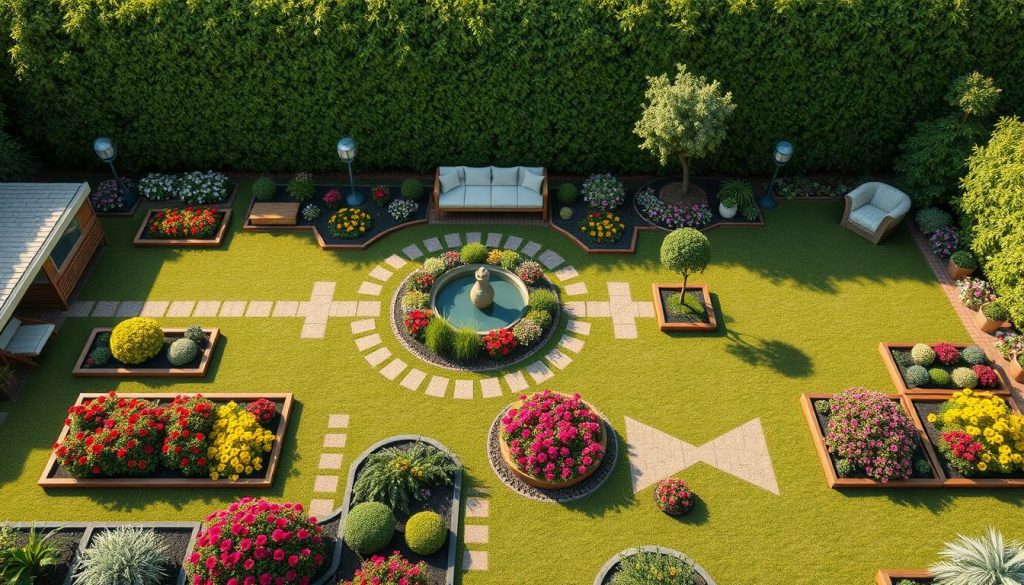
It’s also important to plan walkways and access points. A planner can help you design paths that link your garden’s areas. This makes it easy to move around and keep your garden looking great.
Some important things to think about when planning your garden include:
- Understanding your garden’s terrain and climate
- Picking the right plants and materials
- Creating a layout that’s easy to care for and get around
By keeping these tips in mind and using software or a planner, you can make a beautiful and useful garden. It will be a place you’ll love for many years.
| Garden Layout Element | Importance | Tips |
|---|---|---|
| Zoning | High | Use garden layout software to visualize your design |
| Walkways and Access Points | Medium | Design pathways that connect different areas of your garden |
| Plant Selection | High | Choose plants that are suitable for your garden’s climate and terrain |
Selecting Plants That Thrive
Creating a stunning garden starts with the right plants. It’s key to pick plants that fit your climate and soil. This way, your garden will be beautiful and easy to care for. Remember, the plant hardiness zone is crucial. It shows if a plant can handle extreme temperatures.
Understanding Plant Hardiness Zones
To pick the right plants, know your area’s zone. This ensures your plants survive winter and bloom in spring. Check the USDA Plant Hardiness Zone Map to find your zone. This helps tailor your garden to your climate, using the best design ideas and tips.
Choosing Native vs. Exotic Plants
Deciding between native and exotic plants is important. Native plants fit your local climate and soil, needing less care. Exotic plants bring a unique look but might need more attention. Here’s a quick comparison:
- Native plants: low maintenance, adapted to local climate, supports local ecosystem
- Exotic plants: unique appearance, can thrive in specific conditions, but may require more care
By thinking about these points, you can design a garden that’s beautiful and easy to care for. Whether you choose native or exotic plants, the right selection makes a big difference.
For example, native plants make a garden easy to maintain. Exotic plants add color and interest. Understanding each plant’s needs helps you create a stunning garden that’s low on upkeep.
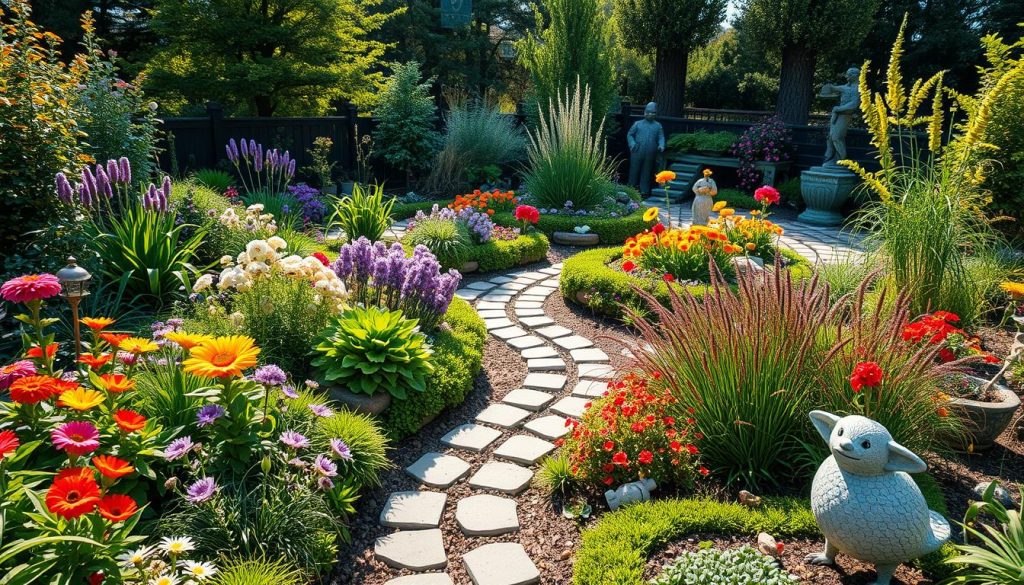
| Plant Type | Maintenance Level | Climate Tolerance |
|---|---|---|
| Native Plants | Low | High |
| Exotic Plants | High | Medium |
Mapping Out Plant Placement
Creating a stunning garden starts with mapping out plant placement. A garden layout planner is very helpful here. It lets you see your plant arrangement and make changes before you start. Garden layout software helps you try different layouts. You can find the perfect mix of plants, considering sunlight, soil, and how much care they need.
Companion planting is key in plant placement. It’s about pairing plants that help each other grow. For example, marigolds with tomatoes can keep nematodes away. Basil with roses makes them smell better. The right pairs create a healthy and beautiful garden.
Companion Planting Strategies
- Planting flowers that attract pollinators, such as bees and butterflies, near fruit and vegetable plants
- Pairing plants with different growth habits, such as tall sunflowers with shorter flowers like zinnias
- Using plants with different soil requirements, such as planting succulents with plants that prefer well-draining soil
Considering Height and Spread
When planning plant placement, think about each plant’s height and spread. This makes your garden look good, with a mix of tall and short plants. A garden layout planner helps ensure plants have room to grow. It also makes your garden easy to care for and enjoy.
Adding Hardscape Elements
Hardscape elements are key to a beautiful outdoor space. They help define areas in my backyard garden. Paths and patios make my garden more inviting.
A good outdoor space layout boosts my garden’s look. I use raised beds and borders for interest and depth. This makes my garden more beautiful and helps with planning.
When adding hardscape elements, I think about a few things. I choose materials that match my garden’s style. I make sure paths and patios are safe and useful.
- Choosing materials that complement my garden’s style and theme
- Ensuring that paths and patios are functional and safe
- Using raised beds and borders to create a sense of depth and visual interest
These elements help me create a beautiful outdoor space. It meets my DIY garden planning needs and improves my backyard garden layout.
| Hardscape Element | Purpose | Benefits |
|---|---|---|
| Paths | Define different areas of the garden | Create a sense of flow, make the garden more inviting |
| Patio | Provide a seating area | Enhance the overall aesthetic of the garden, create a functional space |
| Raised Beds | Add visual interest, create a sense of depth | Help with DIY garden planning, create separate areas for different plants and features |
Enhancing Wildlife and Pollinator Access
As I work on my garden, I see how vital it is to welcome wildlife and pollinators. By using landscaping tips to attract insects and birds, my garden’s health and diversity will grow. A smart plant arrangement is key to a thriving ecosystem.
Attracting Beneficial Insects
To draw in bees and butterflies, I’ll add native plants that offer nectar and pollen. Some great options are:
- Lavender
- Coneflower
- Black-eyed Susan
These plants will not only attract beneficial insects but also beautify my garden, fitting my design ideas perfectly.
Creating Bird-Friendly Spaces
To make my garden bird-friendly, I’ll add bird feeders, baths, and native plants for shelter and food. These landscaping tips will turn my garden into a bird and wildlife haven, boosting its beauty and use.
By applying these tips, my garden will flourish and support local wildlife. It will also reflect my care for a well-planned plant arrangement.
Watering Considerations for My Garden
Creating a stunning and sustainable garden means paying close attention to watering. As I use garden layout software, I focus on saving water and reducing waste. It’s key to plan a garden layout that uses efficient irrigation systems.
A garden layout planner helps me design a system tailored to my garden’s needs. I consider soil type, climate, and plant selection. This way, I ensure the right amount of water reaches the right plants at the right time.
Designing an Efficient Irrigation System
Creating an efficient irrigation system requires careful thought. Key factors include:
- Soil type and moisture levels
- Climate and weather patterns
- Plant selection and watering needs
By considering these, I can make a system that wastes less water. This ensures my plants get the water they need to grow well.
Planning for Rainwater Harvesting
Planning for rainwater harvesting is crucial for a sustainable garden. Collecting and storing rainwater cuts down my water bill. A garden layout planner helps me design a system that includes rainwater harvesting and efficient irrigation. This makes my garden more eco-friendly and cost-effective.
Seasonal Considerations in Garden Planning
When I plan my outdoor space, I think about the seasons. A good backyard garden layout can look great all year. I focus on planting for color all year to keep things interesting.
I choose plants that do well in each season. In spring, I plant bulbs and perennials for summer blooms. In fall, I add mums and asters for a pop of color.
Planting for Year-Round Color
- Choose plants with varying bloom times to ensure constant color
- Incorporate evergreen shrubs and trees for winter interest
- Use seasonal decorations and lighting to enhance the garden’s ambiance
Preparing for Seasonal Changes
To get the most out of my garden, I adjust my plans for each season. I use seasonal plants, decorations, and lights. This makes my garden welcoming all year.
Budgeting for My Garden Layout
Creating a stunning garden requires careful budgeting. I must consider the costs of plants, materials, and landscaping tips. A good budget ensures my garden stays beautiful and functional.
I’ll start by estimating the costs of plants and materials. This includes the type and number of plants, soil, fertilizers, and gardening supplies. I’ll also think about the plant arrangement and its impact on my budget. By researching and comparing prices, I can find affordable options.
- Use recycled materials for planters and garden decor
- Choose cost-effective plants that are easy to maintain
- Consider DIY projects, such as building my own garden bench or trellis
By following these tips and being mindful of my budget, I can create a beautiful and functional garden. It will reflect my personal style and meet my needs.
| Category | Estimated Cost |
|---|---|
| Plants and materials | $500 |
| Landscaping and labor | $1,000 |
| Decor and accessories | $200 |
With careful budgeting and planning, I can create a stunning outdoor space. It will be a place I’ll enjoy for years to come.
Maintenance Planning for Longevity
To keep my garden thriving, I need to plan for regular maintenance. This includes tasks like watering, pruning, and fertilizing. A garden layout planner helps me see which areas need more care.
Creating a Routine Maintenance Schedule
A well-planned maintenance schedule keeps my garden healthy. It includes tasks like watering, pruning, and fertilizing. I use garden layout software to plan the best schedule for my plants.
- Watering: Regular watering is key for plant growth. But, too much water can harm them. I use software to find the perfect watering schedule.
- Pruning: Pruning keeps plants in shape and promotes growth. I prune regularly to prevent overgrowth and encourage blooms.
- Fertilizing: Fertilizing gives plants the nutrients they need. I use a balanced fertilizer to support healthy growth and avoid nutrient shortages.
By sticking to a routine maintenance schedule and using the right tools, my garden stays beautiful for years.
Tools and Resources for Effective Care
There are many tools and resources to help with garden maintenance. Some include:
| Tool/Resource | Description |
|---|---|
| Gardening apps | Provide tips and reminders for garden maintenance |
| Online tutorials | Offer step-by-step instructions for various gardening tasks |
| Local gardening communities | Provide a network of experienced gardeners who can offer advice and support |
Inspiring Garden Layout Examples
Reflecting on my garden journey, I’m thrilled to share inspiring examples. These have caught my eye and sparked my creativity. They range from my personal favorites to gardens that push me to improve my space.
Personal Favorites from My Garden
I’m proud of my garden’s vibrant colors. I chose blooms that look great together. My dahlias and hydrangeas mix warm and cool colors, creating a stunning view.
Gardens That Inspire Me to Improve My Own
I’m always looking to make my garden better. The Butchart Gardens in British Columbia, Canada, inspire me. Their design, plant variety, and use of hardscaping elements motivate me to try new things.
As I keep working on my garden, I’m excited to see it grow. Drawing inspiration from my favorites and other gardens, I’m confident in creating a beautiful outdoor space.

